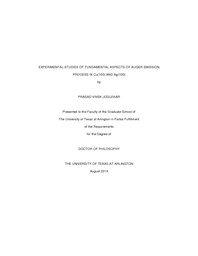
ATTENTION: The works hosted here are being migrated to a new repository that will consolidate resources, improve discoverability, and better show UTA's research impact on the global community. We will update authors as the migration progresses. Please see MavMatrix for more information.
Show simple item record
| dc.contributor.author | Joglekar, Prasad Vivek | en_US |
| dc.date.accessioned | 2014-09-17T17:31:28Z | |
| dc.date.available | 2014-09-17T17:31:28Z | |
| dc.date.issued | 2014-09-17 | |
| dc.date.submitted | January 2014 | en_US |
| dc.identifier.other | DISS-12788 | en_US |
| dc.identifier.uri | http://hdl.handle.net/10106/24777 | |
| dc.description.abstract | Auger spectra at the low energies are accompanied by large contributions unrelated to the Auger transition. The Auger unrelated contributions can obscure the Auger peak and affect the quantitative analysis of the materials under investigation. In this dissertation we present a methodology to measure experimentally the Auger unrelated contributions and eliminate it from the Auger spectrum for obtaining an Auger spectrum inherent to the Auger transition. We used Auger Photoelectron Coincidence Spectroscopy (APECS) to obtain the Auger spectrum. APECS measures the Auger spectrum in coincidence with the core energy level and thus discriminating the contributions arising from secondary electrons and electrons arising from the non-Auger transition. Although APECS removes most of the Auger unrelated contributions, it cannot distinguish the contribution which is measured in coincidence with the inelastically scattered valence band electrons emitted at the core energy. To measure this inelastically scattered valence band contribution we did a series of measurements on Ag(100) to study NVV Auger spectrum in coincidence with 4p energy level and Cu(100) to study MVV Auger spectrum in coincidence with 3p energy level. The coincidence detection of the core and Auger-valence electrons was achieved by the two cylindrical mirror analyzers (CMAs). One CMA was fixed over a range of energies in between VB and core energy level while other CMA scanned corresponding low energy electrons from 0 to70eV. The spectrums measured were fit to a parameterized function which was extrapolated to get an estimate of inelastically scattered valence band electrons. The estimated contribution was subtracted for the Ag and Cu APECS spectrum to obtain a spectrum solely due to Auger transition with inelastically scattered Auger electron and multi Auger decay contributions associated with the transition. In the latter part of this dissertation, we propose a theoretical model based on the spectral intensity contributions arising from elastically scattered electrons from the atomic layers and relate it with the data obtained from our experiments to estimate the Auger related contribution. | en_US |
| dc.description.sponsorship | Weiss, Alexander H. | en_US |
| dc.language.iso | en | en_US |
| dc.publisher | Physics | en_US |
| dc.title | Experimental Studies Of Fundamental Aspects Of Auger Emission Process In Cu(100) And Ag(100) | en_US |
| dc.type | Ph.D. | en_US |
| dc.contributor.committeeChair | Weiss, Alexander H. | en_US |
| dc.degree.department | Physics | en_US |
| dc.degree.discipline | Physics | en_US |
| dc.degree.grantor | University of Texas at Arlington | en_US |
| dc.degree.level | doctoral | en_US |
| dc.degree.name | Ph.D. | en_US |
Files in this item
- Name:
- Joglekar_uta_2502D_12788.pdf
- Size:
- 8.880Mb
- Format:
- PDF
This item appears in the following Collection(s)
Show simple item record


